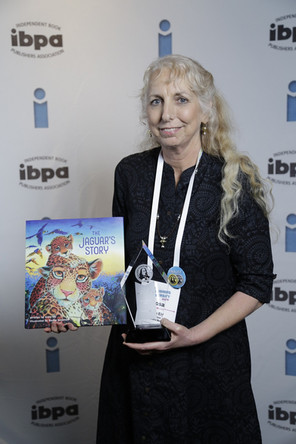Winning Two Benjamin Franklin Awards by Kosarupa dasi
- VMNA
- Jul 28, 2019
- 3 min read
Updated: Jul 30, 2019
By Kosarupa dasi (Kosa Ely)
The Benjamin Franklin Award is the one I wanted our children’s picture book, The Jaguar’s Story, to win the most. In its 32nd year, this prestigious award is regarded as one of the highest national honors for both traditional and independent publishers, recognizing excellence in book editorial and design. As the publisher-author, in my mind it had the same weight as winning an Oscar, an Emmy, or a Grammy.
During the months leading to the announcement, The Jaguar’s Story won First Place and Book of the Year in three other national and international contests, and our book trailer took First Place too.
When I received the email that we were Benjamin Franklin finalists for Children’s Picture Book of the Year, I was overwhelmed with emotion. The next day I received another email. The Jaguar’s Story was also a Benjamin Franklin finalist for Design. Woo-hoo! Sharing this news with artist Radhe Gendron, and graphic artists Govinda Cordua and Raghu-nandini Consbruck was the best part for me. Without these three artists this book would still be a text file. Radhe brought the story to life through her stunning illustrations, and Govinda and Raghu with their design.
So we knew for sure we had won two Benjamin Franklin Silver awards. But would we win the Gold? We wouldn’t know until the Awards banquet in Chicago.
A little back story:
Switching from producing a new devotional story to an eco story was a calculated choice. If the illustrator and I could make a name for ourselves in the highly competitive children’s book marketplace, then our devotional books would have a stronger chance of being noticed and respected. And if I kept a similar theme to my previous book, The Peaceable Forest, India’s Tale of Kindness to Animals—the two books could be sold as a set, boosting recognition and sales for both.
The Jaguar’s Story is an eco book that pulls on the heartstrings of the reader, confronting them with the plight of wildlife and the future of the rainforest because of man’s choices and carelessness. It’s heavy subject matter for a children’s picture book, and I was told I shouldn’t do it. So I dug in my heels, more determined than ever. Having worked with Indigenous communities and nonprofits in the Amazon rainforest for more than a decade, I knew too much. The exploitation of the forests, people and wildlife, primarily due to cattle ranching and mining, continues to escalate. But who’s talking about it? Creating this book could potentially reach a wide audience and influence a generation of children.
At the Awards banquet in Chicago, my dear friend Sri Rupa dasi accompanied me. It was hard to eat my quinoa and veggie dish as the suspense mounted. Another book won the Gold in Children’s Picture book category. The wave of disappointment was real. Now the suspense was even greater. Then it occurred to me, if I did win the Gold, I was expected to speak and hadn’t prepared anything. I watched several Gold winners ramble their acceptance speech, clearly nervous. Others did the never ending verbal thank you list. Yikes! Why didn’t I prepare and practice something? I retreated into my head to review my jaguar and rainforest talking points. Minutes later The Jaguar’s Story, Chandra Media, was announced as the Gold winner for book design! Everyone sitting at my table cheered me on as I fumbled my way up to the stage.
My acceptance speech began by transporting the audience to the Amazon rainforest, explaining the predicament jaguars and other wildlife face, and why the message of this book is very real and important. I asked the audience to be part of the solution for the sake of the children. “This award will help The Jaguar’s Story have greater reach and impact. As the author-publisher, I am receiving this award on behalf of our team. I want to especially thank artist extraordinaire, Radhe Gendron for bringing the story to life with her beautiful, detailed art, and graphic designers Govinda Cordua and Raghu-nandini Consbruck who have earned this desgn award.” I also thanked IBPA publishing association and the Benjamin Franklin award judges. Holding up the beautiful crystal trophy I looked out on the crowd and added, “Wow! Receiving this Benjamin Franklin award means so much to us! I’m so STOKED!”
Chandra Media team:
Radhe Gendron: illustrator, Nitai Ely: editor, Govinda Cordua & Raghu Nandini Consbruck: graphic design, website, advisors, Krishna Shakti Sanchez: book trailer & crowd-funding video producer, Pranada Comtois: book production advisor, Bada Haridas: audio book producer










Comments